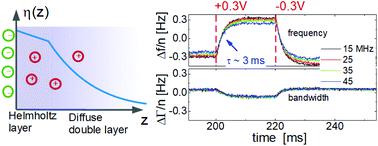Our official English website, www.x-mol.net, welcomes your
feedback! (Note: you will need to create a separate account there.)
Kinetics of viscoelasticity in the electric double layer following steps in the electrode potential studied by a fast electrochemical quartz crystal microbalance (EQCM)
Analyst ( IF 3.6 ) Pub Date : 2021-2-2 , DOI: 10.1039/d0an01965h Christian Leppin 1, 2, 3, 4 , Astrid Peschel 1, 2, 3, 4 , Frederick Sebastian Meyer 1, 2, 3, 4 , Arne Langhoff 1, 2, 3, 4 , Diethelm Johannsmann 1, 2, 3, 4
Analyst ( IF 3.6 ) Pub Date : 2021-2-2 , DOI: 10.1039/d0an01965h Christian Leppin 1, 2, 3, 4 , Astrid Peschel 1, 2, 3, 4 , Frederick Sebastian Meyer 1, 2, 3, 4 , Arne Langhoff 1, 2, 3, 4 , Diethelm Johannsmann 1, 2, 3, 4
Affiliation

|
Changes in the viscoelasticity of the electric double layer following steps in electrode potential were studied with an electrochemical quartz crystal microbalance (EQCM). The overtone scaling was the same as in gravimetry (−Δf/n ≈ const with Δf the frequency shift and n the overtone order). Changes in half-bandwidth were smaller than changes in frequency. This Sauerbrey-type behaviour can be explained with either adsorption/desorption or with changes of the (Newtonian) viscosity of the diffuse double layer. While the QCM data alone cannot distinguish between these two processes, independent information supports the explanation in terms of double layer viscosity. Firstly, the magnitudes of the frequency response correlated with the expected changes of the viscosity-density product in the diffuse double layer. With regard to viscosity, these expectations are based on the viscosity B–coefficients as employed in the Jones–Dole equation. Expected changes in density were estimated from the densities of the respective salts. Secondly, the explanation in terms of liquid-like response matches the kinetic data. The response times of frequency and bandwidth were similar to the response times of the charge as determined with electrochemical impedance spectroscopy (EIS). Rearrangements in the Helmholtz layer should have been slower, given this layer's rigidity. Kinetic information obtained with a QCM can aid the understanding of processes at the electrode–electrolyte interface.
中文翻译:

快速电化学石英晶体微量天平(EQCM)研究电极电位之后,双电层中的粘弹性动力学
用电化学石英晶体微量天平(EQCM)研究了双电层的粘弹性随电极电位的变化。泛音缩放的相同,在重量分析法(-Δ ˚F / Ñ ≈常量与Δ ˚F频移和Ñ泛音顺序)。半带宽的变化小于频率的变化。Sauerbrey型行为可以用吸附/解吸或扩散双层的(牛顿)粘度变化来解释。尽管仅QCM数据无法区分这两个过程,但独立信息支持双层粘度的解释。首先,频率响应的幅度与扩散双层中粘度密度乘积的预期变化相关。关于粘度,这些期望值是基于Jones–Dole公式中使用的B系数。从各个盐的密度估计密度的预期变化。其次,关于类液体反应的解释与动力学数据相匹配。频率和带宽的响应时间类似于用电化学阻抗谱(EIS)确定的电荷响应时间。考虑到该层的刚性,Helmholtz层中的重排应该更慢。通过QCM获得的动力学信息可以帮助理解电极-电解质界面的过程。
更新日期:2021-02-05
中文翻译:

快速电化学石英晶体微量天平(EQCM)研究电极电位之后,双电层中的粘弹性动力学
用电化学石英晶体微量天平(EQCM)研究了双电层的粘弹性随电极电位的变化。泛音缩放的相同,在重量分析法(-Δ ˚F / Ñ ≈常量与Δ ˚F频移和Ñ泛音顺序)。半带宽的变化小于频率的变化。Sauerbrey型行为可以用吸附/解吸或扩散双层的(牛顿)粘度变化来解释。尽管仅QCM数据无法区分这两个过程,但独立信息支持双层粘度的解释。首先,频率响应的幅度与扩散双层中粘度密度乘积的预期变化相关。关于粘度,这些期望值是基于Jones–Dole公式中使用的B系数。从各个盐的密度估计密度的预期变化。其次,关于类液体反应的解释与动力学数据相匹配。频率和带宽的响应时间类似于用电化学阻抗谱(EIS)确定的电荷响应时间。考虑到该层的刚性,Helmholtz层中的重排应该更慢。通过QCM获得的动力学信息可以帮助理解电极-电解质界面的过程。











































 京公网安备 11010802027423号
京公网安备 11010802027423号